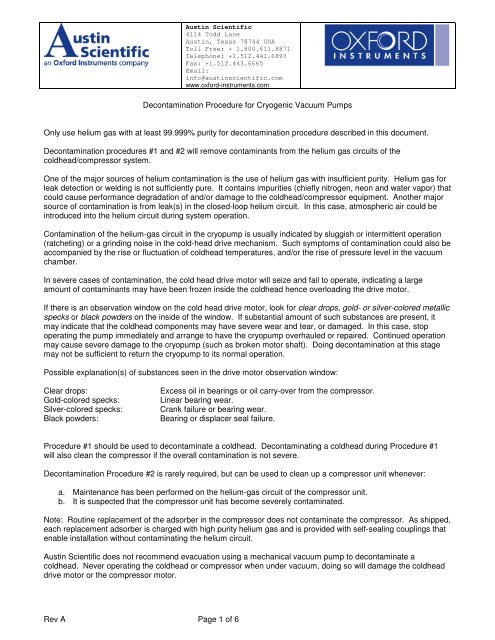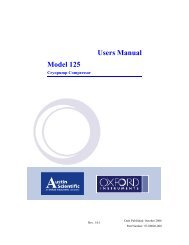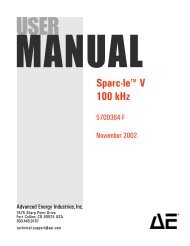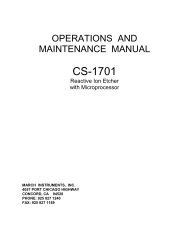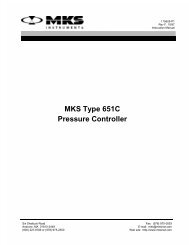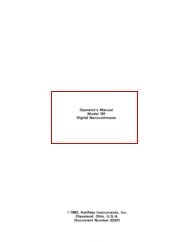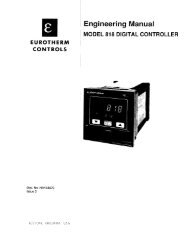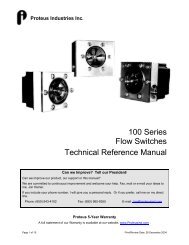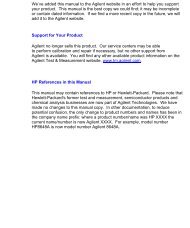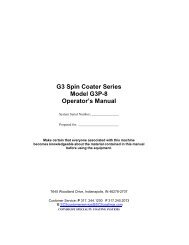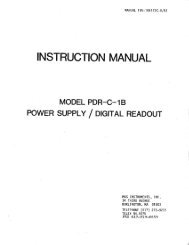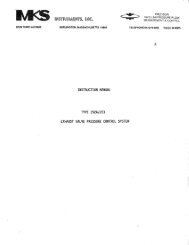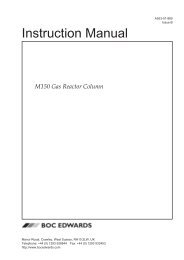Decontamination Procedure for Cryogenic Vacuum Pumps
Decontamination Procedure for Cryogenic Vacuum Pumps
Decontamination Procedure for Cryogenic Vacuum Pumps
You also want an ePaper? Increase the reach of your titles
YUMPU automatically turns print PDFs into web optimized ePapers that Google loves.
Table 1 Static Pressure* <strong>for</strong> Different Cryopump/Compressor ConfigurationsCryopump Compressor Static Pressure[PSIG; ± 5 PSIG]CT100ASC M125CTI – SC, 8200, 8300ASC Conversion of CTI SC, 8200, 8300190250190CT-7CP-8/CT-8CP-10/CT-10CP-16/CT-400CT-500ASC M125CTI – SC, 8200, 8300ASC Conversion of CTI SC, 8200, 8300ASC M125CTI – SC, 8200, 8300ASC Conversion of CTI SC, 8200, 8300ASC M450ASC M600CTI – 1020, 8500, 8510CTI 9600CTI 9700ASC M450ASC M600CTI – 1020, 8500, 8510CTI 9600CTI 9700ASC M450ASC M600CTI – 1020, 8500, 8510CTI 9600CTI 9700*These pressure levels are valid when both the cold head and compressor are at nominal room temperature (60 ~80°F)190250190190250190200250200250225200250200250225200250200250225Rev A Page 4 of 6
DECONTAMINATION PROCEDURE #2Note: For this procedure, a maintenance manifold (p/n 10134) is required. Contact Austin Scientific (1-512-441-6893) to acquire this tool. Only connect the helium gas supply line of the compressor to the maintenancemanifold. Do NOT connect the return line of the compressor to the manifold, doing so will damage thecompressor during decontamination.When the level of contamination within the helium gas circuits of a cryopump is not severe, <strong>Procedure</strong> #1 willgenerally decontaminate the compressor unit as well as the cold head. This is because contaminants in thecompressor will have become isolated inside the cold head during the procedure.Use decontamination <strong>Procedure</strong> #2 to decontaminate the compressor unit when the following conditions exist:a. Maintenance has been per<strong>for</strong>med on the helium gas circuit or the oil circuit of the compressor unit (<strong>for</strong>example, replacing a filter or an orifice). For this condition, commence the cleanup with STEP #3 below.b. It is suspected that the compressor unit has become SEVERELY contaminated. For this condition,commence the cleanup with STEP 1.CAUTIONS:1. WHEN CONNECTING OR DISCONNECTING A SELF-SEALING COUPLING, ALWAYS USE TWOWRENCHES. THIS IS TO AVOID LOOSENING THE BODY OF THE COUPLING FROM ITS ADAPTER.2. ALWAYS CHECK THAT THE FLAT RUBBER GASKET IS IN PLACE BEFORE CONNECTING ASELF-SEALING COUPLING.STEP 1 – Shut down the cryopump and compressor.STEP 2 – IMMEDIATELY disconnect the helium supply and return lines from the gas supply and gas returnconnectors on the coldhead, leave the lines attached at the compressor would decontaminate the lines with thecompressor. Disconnect the adsorber inside the compressor if it is to be replaced.Note: If the cold head is contaminated, use <strong>Decontamination</strong> <strong>Procedure</strong> #1 (STEPS 4 through 14)STEP 3 – Connect the maintenance manifold in-line on the supply side of the compressor, using the availablehelium gas supply line of the compressor. Leave the helium gas return flex line unconnected.CAUTION: Connecting both supply and return lines of the compressor to the maintenance manifold <strong>for</strong>decontamination could seriously damage the compressor.STEP 3 – Follow the steps below to attach a helium gas cylinder, regulator and charging line to the maintenancemanifold and purge the regulator and line of air as follows:a. Install a gas regulator (0-400 psig) on the helium bottleb. Open the regulator by turning clockwise on the handle until it engages the diaphragm and turnsapproximately 1/8 to 1/4 turn beyond engagementc. Open any other valves on the regulatord. Open the valve on the helium bottlee. IMMEDIATELY back off on the regulator handle until helium stops flowingCAUTION: Failure to open the regulator be<strong>for</strong>e opening the helium supply bottle valve will result incontamination of the helium gas.Rev A Page 5 of 6
f. Loosely attach the 1/4” flair line between the regulator and the charge valve (small Swagelok valve withblack knob) on the maintenance manifold.g. Purge the line <strong>for</strong> at least 15 seconds be<strong>for</strong>e tightening the flare nut.STEP 4 –a. Pressurize the compressor unit to its proper static charge pressure (see Table 1) by opening the chargevalve (small Swagelok valve with black knob) on the maintenance manifoldb. Close the charge valve on the maintenance manifold when the desired pressure level is reachedc. Slowly open the discharge valve (with red handle) and depressurize the compressor to 30 – 50 psigd. Repeat the purge procedure 4a through 4c four times.e. With the compressor unit pressurized to the static charge pressure, run the compressor <strong>for</strong> 1 to 2 minutesf. Reduce the static pressure of the compressor unit to a level of between 30 to 50 psig by slowly openingthe discharge valve (with red handle) on the maintenance manifold.STEP 5 – Repeat STEP 4 <strong>for</strong> four more times.Note: There will be a total of 25 purges and a total of 5 runs of the compressor unit.STEP 5 – If the adsorber was disconnected, replace or reconnect the existing unit.STEP 6 – Verify that compressor unit is charged to proper static charge pressure shown in Table 1.CAUTION: Check that the flat rubber gaskets of the self-sealing couplings (Aeroquip connectors) are in place andare not damaged be<strong>for</strong>e reconnecting. Missing or damaged gaskets will cause the connectors to leak, and couldresult in further contamination.STEP 7 – Reconnect the helium return and supply lines to the gas-supply and gas-return connectors on thecompressor unit.STEP 8 – Restart the compressor and cryopump (after cryopump is also decontaminated, see <strong>Procedure</strong> #1).Note: As the cryopump continues to operate, any residual contamination of the compressor unit will have becomeisolated in the cold head and can be readily removed from the cold head by using <strong>Decontamination</strong> <strong>Procedure</strong> #1.STEP 9 – If further decontamination of the coldhead is desired, wait after coldhead running <strong>for</strong> 48 hours or morebe<strong>for</strong>e conducting <strong>Decontamination</strong> <strong>Procedure</strong> #1 (starting from STEP 2 in <strong>Procedure</strong> #1).Rev A Page 6 of 6


